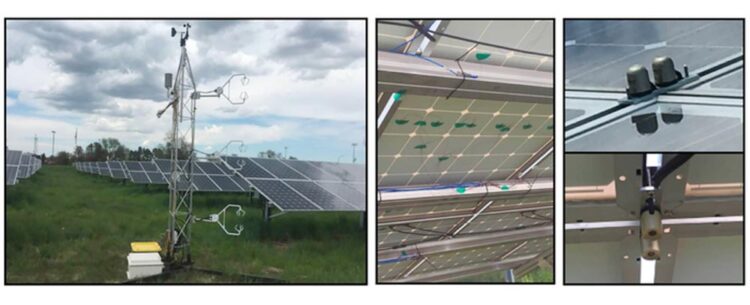Cooling down solar cells, naturally

Real-world data from monitoring equipment at the Denver Federal Center was used to investigate how the spacing between solar panels can help them cool down.
Credit: Smith et al.
Photovoltaics are more efficient when they operate at lower temperatures, which can be achieved in solar farms that space out arrays and use the wind to their advantage.
A bright, sunny, cloudless day might seem like the optimal setting for solar cells. But too much sun, and too much heat, can actually reduce the efficiency of photovoltaics.
As operating temperature rises by 1 degree Celsius, traditional silicon-based solar cells will lose about 0.5% efficiency. In a typical photovoltaic plant, where modules operate nearly 25 degrees Celsius above the ambient temperature, energy losses can reach 12%.
This necessitates effective cooling measures for solar farms. In the Journal of Renewable and Sustainable Energy, by AIP Publishing, researchers from Portland State University, the University of Utah, and the National Renewable Energy Laboratory explored how to exploit the geometry of solar farms to enhance natural cooling mechanisms.
Some modern cooling methods force wind or water to interact with solar panel surfaces, while others employ specific materials with less thermal sensitivity. However, these techniques require significant resources to operate. In contrast, a solar farm with optimally spaced panels facing the correct direction could cool itself through convection using the surrounding wind.
The team improved models that calculate how much energy a given solar plant will produce based on factors such as material, environmental conditions, and panel temperature. They specifically focused on the geometry of solar farms, or how much “gappy-ness” was present between the panels.
“Our hypothesis was that the most precise estimate of solar plant convection, and ultimately production efficiency, must consider the farm as a whole and all possible configuration changes,” said author Sarah Smith, of Portland State University.
By design, it is rare that any two solar plants have the same setup. Each is uniquely designed to optimize solar irradiance and conform to its surrounding environment. For example, the tilt of solar panels changes with latitude and their height varies with vegetation. Spacing of rows often depends on how much land is available.
“This means that the heat-removing wind flow will also move differently throughout each solar plant based on its arrangement, ultimately changing how efficiently heat is removed from module surfaces,” said Smith.
The researchers performed wind tunnel experiments and high-resolution simulations and collected real-world data to corroborate their model. They investigated photovoltaic heating and cooling with variations in module height, row spacing, angle, and wind. Raising the height of solar cells and increasing the spacing between panel rows increased power output by 2% to 3%.
“This correlation between geometry and efficiency is a huge step toward predicting convective cooling for solar farms based on their inherently unique arrangements,” said Smith. “It paves the way for more accurate energy generation and cost prediction models in industry.”
The article “Viewing convection as a solar farm phenomenon broadens modern power predictions for solar photovoltaics” is authored by Sarah E. Smith, Brooke J. Stanislawski, Byron K. Eng, Naseem Ali, Timothy J Silverman, Marc Calaf, and Raúl Bayoán Cal. The article will appear in the Journal of Renewable and Sustainable Energy on Nov. 29, 2022 (DOI: 10.1063/5.0105649). After that date, it can be accessed at https://doi.org/10.1063/5.0105649.
ABOUT THE JOURNAL
Journal of Renewable and Sustainable Energy is an interdisciplinary journal that publishes across all areas of renewable and sustainable energy relevant to the physical science and engineering communities. Topics covered include solar, wind, biofuels and more, as well as renewable energy integration, energy meteorology and climatology, and renewable resourcing and forecasting. See https://aip.scitation.org/journal/rse.
Journal: Journal of Renewable and Sustainable Energy
DOI: 10.1063/5.0105649
Article Title: Viewing convection as a solar farm phenomenon broadens modern power predictions for solar photovoltaics
Article Publication Date: 29-Nov-2022
Media Contact
Ashley Piccone
American Institute of Physics
media@aip.org
Office: +1-301-209-3090
All latest news from the category: Power and Electrical Engineering
This topic covers issues related to energy generation, conversion, transportation and consumption and how the industry is addressing the challenge of energy efficiency in general.
innovations-report provides in-depth and informative reports and articles on subjects ranging from wind energy, fuel cell technology, solar energy, geothermal energy, petroleum, gas, nuclear engineering, alternative energy and energy efficiency to fusion, hydrogen and superconductor technologies.
Newest articles
Faster, more energy-efficient way to manufacture an industrially important chemical
Zirconium combined with silicon nitride enhances the conversion of propane — present in natural gas — needed to create in-demand plastic, polypropylene. Polypropylene is a common type of plastic found…

Energy planning in Ghana as a role model for the world
Improving the resilience of energy systems in the Global South. What criteria should we use to better plan for resilient energy systems? How do socio-economic, technical and climate change related…

Artificial blood vessels could improve heart bypass outcomes
Artificial blood vessels could improve heart bypass outcomes. 3D-printed blood vessels, which closely mimic the properties of human veins, could transform the treatment of cardiovascular diseases. Strong, flexible, gel-like tubes…





















